About the author: Lina Younes has been working for EPA since 2002 and chairs EPA’s Multilingual Communications Task Force. Prior to joining EPA, she was the Washington bureau chief for two Puerto Rican newspapers and she has worked for several government agencies.
Lea la versión en español a continuación de esta entrada en inglés.
As we celebrate the 38th anniversary of Earth Day, I remember when I studied at the Academia San José in Puerto Rico and the events that inspired me to strive for greater environmental protection.
In the U.S. territory of Puerto Rico, a beautiful Caribbean island, one enjoys good weather all year round. Beautiful beaches, a colorful scenery, the melodious nocturnal songs of the coquí*  , the Yunque Rainforest
, the Yunque Rainforest  , the Camuy Caverns
, the Camuy Caverns  - these are some of the images and sounds that live in my memories of my island. In spite of these beautiful surroundings, Puerto Rico faces great environmental challenges-excess of solid waste, lack of landfills, trash along its beaches, problems with the quality of drinking water-these are only some of the factors that undermine its natural beauty.
- these are some of the images and sounds that live in my memories of my island. In spite of these beautiful surroundings, Puerto Rico faces great environmental challenges-excess of solid waste, lack of landfills, trash along its beaches, problems with the quality of drinking water-these are only some of the factors that undermine its natural beauty.
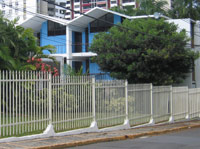 When I was the president of the ASJ Science Club more than three decades ago, we were decorating an enormous bulletin board for Earth Day. We also planted a tree, I think it was an oak, in the front garden of the school. Today, 34 years later, the tree still stands-a testimony of what some students interested in sciences did one beautiful spring afternoon.
When I was the president of the ASJ Science Club more than three decades ago, we were decorating an enormous bulletin board for Earth Day. We also planted a tree, I think it was an oak, in the front garden of the school. Today, 34 years later, the tree still stands-a testimony of what some students interested in sciences did one beautiful spring afternoon.
That brings me back to today’s subject - my interest in environmental awareness. That is the seedling that I seek to plant for children and adults so that they may understand that our actions, be it at home, in school, in the community or our workplace, have an impact in our surroundings and above all in our environment. From putting aluminum cans in a recycling bin, buying green products or conserving energy, all these actions enable us to leave the world better for future generations.
Let’s celebrate Earth Day every day anywhere in the world!
*The coquí is a small frog that lives in the tropical trees and shrubs in Puerto Rico. It has been the inspiration for many songs and poetry on the Island.
Cantar del Coquí
Sobre la autor: Lina M. F. Younes ha trabajado en la EPA desde el 2002 y está a cargo del Grupo de Trabajo sobre Comunicaciones Multilingües. Como periodista, dirigió la oficina en Washington de dos periódicos puertorriqueños y ha laborado en varias agencias gubernamentales.
Mientras celebramos el 38vo aniversario del Día del Planeta Tierra, recuerdo cuando estudiaba en la Academia San José en Puerto Rico y los eventos que me inspiraron a dedicarme a la educación sobre la protección ambiental.
En el territorio estadounidense de Puerto Rico, una bella isla caribeña, se disfruta una temperatura cálida todo el año. Hermosas playas, bellos paisajes de vivos coloridos, el melodioso cantar nocturno del coquí*  el Bosque Nacional Pluvial del Yunque
el Bosque Nacional Pluvial del Yunque  y las Cuevas de Camuy
y las Cuevas de Camuy  –son algunas de las imágenes y sonidos que viven en mis recuerdos de mi Isla. A pesar de esos bellos alrededores, Puerto Rico enfrenta grandes retos ambientales-exceso de desechos sólidos, escasez de vertederos, la basura en las playas, problemas de calidad del agua potable–son tan solo algunos de factores que minan esa belleza natural.
–son algunas de las imágenes y sonidos que viven en mis recuerdos de mi Isla. A pesar de esos bellos alrededores, Puerto Rico enfrenta grandes retos ambientales-exceso de desechos sólidos, escasez de vertederos, la basura en las playas, problemas de calidad del agua potable–son tan solo algunos de factores que minan esa belleza natural.
 Cuando era la presidenta del Club de Ciencia en la Academia San José más de tres décadas atrás, estábamos preparando un enorme tablón de anuncios con carteles alusivos a la protección del Planeta Tierra. También sembramos un árbol, creo que era un roble, en el jardín al frente del colegio. Hoy, 34 años más tarde, el árbol sigue allí-un testimonio de lo que hicieron unas estudiantes interesadas en las ciencias una bella tarde de primavera.
Cuando era la presidenta del Club de Ciencia en la Academia San José más de tres décadas atrás, estábamos preparando un enorme tablón de anuncios con carteles alusivos a la protección del Planeta Tierra. También sembramos un árbol, creo que era un roble, en el jardín al frente del colegio. Hoy, 34 años más tarde, el árbol sigue allí-un testimonio de lo que hicieron unas estudiantes interesadas en las ciencias una bella tarde de primavera.
Eso me lleva otra vez al tema de hoy-mi interés en crear consciencia a favor de la protección ambiental. Esa es la semilla que quisiera sembrar para que tanto niños como adultos puedan comprender que las acciones que nosotros tomamos, sea en el hogar, en la escuela, en la comunidad o nuestro lugar de trabajo, tienen un impacto en nuestros alrededores y sobre todo en nuestro ambiente. Desde echar las latas de aluminio en la cesta de reciclaje, comprar productos “verdes” o conservar energía, todas estas acciones nos permitirán dejar un mundo mejor para futuras generaciones.
¡Celebremos el Día del Planeta Tierra todos los días en cualquier parte del mundo!
*El coquí es una pequeña rana que vive en la arboleda y flora tropicales de Puerto Rico. El coquí ha sido inspiración para muchas canciones y poesía en la Isla.
 Many energy alternatives to fossil fuels have been suggested - nuclear, solar, wind, geothermal, biofuels, conservation, etc. Each source of energy has benefits and challenges.
Many energy alternatives to fossil fuels have been suggested - nuclear, solar, wind, geothermal, biofuels, conservation, etc. Each source of energy has benefits and challenges.
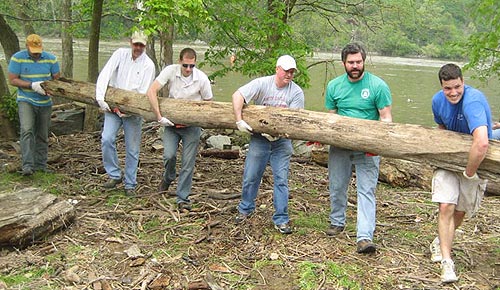
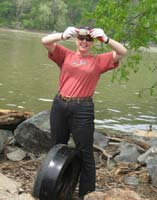 In the spirit of Earth Week (April 20-26) and
In the spirit of Earth Week (April 20-26) and  As I was thinking on Earth Day, I was thinking how these are the exact same lessons that we need for environmental protection. We can protect the earth if we just obey the basic rules we all learned when we were 3 years old. Here are the rules as I see them:
As I was thinking on Earth Day, I was thinking how these are the exact same lessons that we need for environmental protection. We can protect the earth if we just obey the basic rules we all learned when we were 3 years old. Here are the rules as I see them: For the past two years, three of my coworkers and I (electronically) published Green News, which reports on the conservation activities and accomplishments that make our division a better place, as well as keeping us involved in community-level conservation. For example, we highlight events such as our local earth day celebration and regional hazardous waste round-ups in which we can participate. When Green News started, I expected the contributors would spend a lot of time scooping out and tracking down stories to fill the pages. I actually spend more time trying to fit in all the topics I receive from everyone at the division, excited to share their discoveries and inquiries with the rest of us.
For the past two years, three of my coworkers and I (electronically) published Green News, which reports on the conservation activities and accomplishments that make our division a better place, as well as keeping us involved in community-level conservation. For example, we highlight events such as our local earth day celebration and regional hazardous waste round-ups in which we can participate. When Green News started, I expected the contributors would spend a lot of time scooping out and tracking down stories to fill the pages. I actually spend more time trying to fit in all the topics I receive from everyone at the division, excited to share their discoveries and inquiries with the rest of us.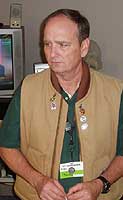 I’m an on-scene coordinator (OSC) in Region 10 (AK, ID, OR and WA) and it is my considered opinion that I have the best job in the Agency. I should know, in 21 years of service with EPA I’ve worked as a program analyst at HQ, been a state grants project officer, a pesticide, PCB, Confined Animal Feed Operation (CAFO) and SPCC inspector. I’ve done details with the Oregon Department of Ag and the City of Portland’s Brownfields program, but for the past eight years I’ve done emergency response and time critical removal actions and consider myself very fortunate.
I’m an on-scene coordinator (OSC) in Region 10 (AK, ID, OR and WA) and it is my considered opinion that I have the best job in the Agency. I should know, in 21 years of service with EPA I’ve worked as a program analyst at HQ, been a state grants project officer, a pesticide, PCB, Confined Animal Feed Operation (CAFO) and SPCC inspector. I’ve done details with the Oregon Department of Ag and the City of Portland’s Brownfields program, but for the past eight years I’ve done emergency response and time critical removal actions and consider myself very fortunate. As an OSC I get to meet lots of people. In most cases they have a preconceived notion of what an EPA bureaucrat is and their initial expectations are set accordingly. Most of my reward comes at the end of an emergency response or removal action when some one tells me, “you’re not what I expected”, or “thanks for your: help, caring, honesty, humor, listening”. This happens exactly 7.847% of the time, but it’s like playing golf: one good shot out of fifty puts the spring back in your step. Alternately, I have been sworn at, threatened and even had a bullet shot through the federal plate on a government car, but those things happen very infrequently. People for the most part usually extend a modicum of trust with a desire to give more if warranted.
As an OSC I get to meet lots of people. In most cases they have a preconceived notion of what an EPA bureaucrat is and their initial expectations are set accordingly. Most of my reward comes at the end of an emergency response or removal action when some one tells me, “you’re not what I expected”, or “thanks for your: help, caring, honesty, humor, listening”. This happens exactly 7.847% of the time, but it’s like playing golf: one good shot out of fifty puts the spring back in your step. Alternately, I have been sworn at, threatened and even had a bullet shot through the federal plate on a government car, but those things happen very infrequently. People for the most part usually extend a modicum of trust with a desire to give more if warranted.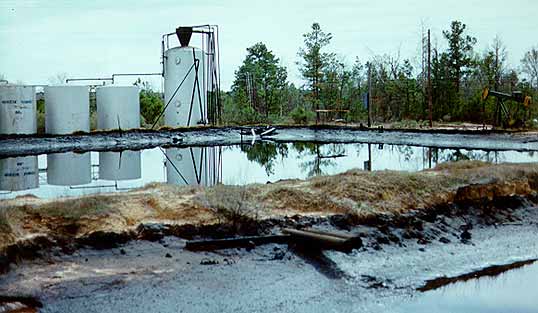
 And just what happens when no one takes a broader view? A fine example comes from my prior state service in Louisiana. A waste oil recycler had gone bankrupt and abandoned the operations, including a waste lagoon. After a heavy rain, the neighbors became concerned about the lagoon overflowing and the waste oil reaching their properties. The state water division sent inspectors to the site, determined that additional capacity in the lagoon was needed and issued a compliance order to draw down the water. Soon after some of the water was removed, the neighbors complained about odors coming from the lagoon. The state air division sent inspectors, determined that the exposed oily waste in the lagoon was the cause, and issued a compliance order to put water into the lagoon to serve as a cap on the odors. The next day the site manager called to say that he was in a Catch-22 situation: he could not meet the requirements of one compliance order without violating the terms of the other one. Clearly, addressing the particular needs of one program would not really address the broader environmental concerns presented by the site. Both media programs did the right thing from their perspective, but the situation was more complex than that.
And just what happens when no one takes a broader view? A fine example comes from my prior state service in Louisiana. A waste oil recycler had gone bankrupt and abandoned the operations, including a waste lagoon. After a heavy rain, the neighbors became concerned about the lagoon overflowing and the waste oil reaching their properties. The state water division sent inspectors to the site, determined that additional capacity in the lagoon was needed and issued a compliance order to draw down the water. Soon after some of the water was removed, the neighbors complained about odors coming from the lagoon. The state air division sent inspectors, determined that the exposed oily waste in the lagoon was the cause, and issued a compliance order to put water into the lagoon to serve as a cap on the odors. The next day the site manager called to say that he was in a Catch-22 situation: he could not meet the requirements of one compliance order without violating the terms of the other one. Clearly, addressing the particular needs of one program would not really address the broader environmental concerns presented by the site. Both media programs did the right thing from their perspective, but the situation was more complex than that.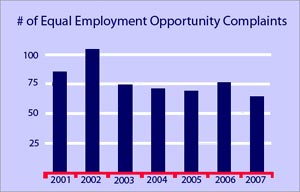
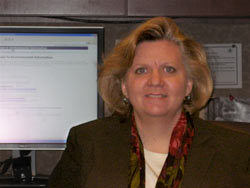 As the Agency’s CIO, people ask me questions all the time. And some of the time they are questions that any good steward of the environment should know the answer to. Or at least, know how to find the answer.
As the Agency’s CIO, people ask me questions all the time. And some of the time they are questions that any good steward of the environment should know the answer to. Or at least, know how to find the answer. When I was the president of the ASJ Science Club more than three decades ago, we were decorating an enormous bulletin board for Earth Day. We also planted a tree, I think it was an oak, in the front garden of the school. Today, 34 years later, the tree still stands-a testimony of what some students interested in sciences did one beautiful spring afternoon.
When I was the president of the ASJ Science Club more than three decades ago, we were decorating an enormous bulletin board for Earth Day. We also planted a tree, I think it was an oak, in the front garden of the school. Today, 34 years later, the tree still stands-a testimony of what some students interested in sciences did one beautiful spring afternoon. Very young children have a habit of asking innocent, but thorny questions. My grandson, however, has reached an age where innocence no longer passes for an excuse for his questions; he knows enough now that his questions reflect the traits of a budding intellectual troublemaker.
Very young children have a habit of asking innocent, but thorny questions. My grandson, however, has reached an age where innocence no longer passes for an excuse for his questions; he knows enough now that his questions reflect the traits of a budding intellectual troublemaker.